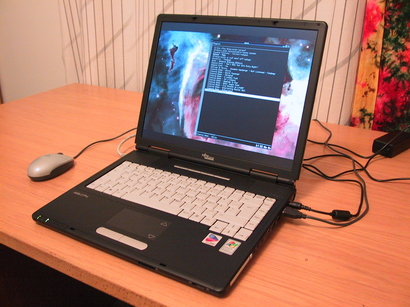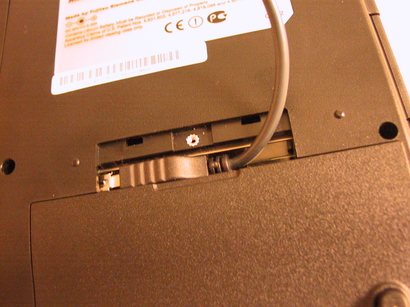I no longer have this machine, but the information is retained for reference.
Fujitsu Siemens Amilo Pro V2020 |
|

Got the machine on 2005-03-16, bought from MJT Finland. Gentoo Linux 2004.3-r1 with stage3-pentium3 installed very smoothly, after using the kernel parameter nohotplug.
| Component | Kernel module(s) | Application driver |
|---|---|---|
| Ethernet | 8139too | |
| USB 2.0 | uhci_hcd, ehci_hcd | |
| Firewire | ieee1394, ohci1394 | |
| PC Card slot | yenta_socket, pcmcia_core | pcmciatools |
| Memory card slot | probably none, see below for problems | |
| Graphics / X | intel-agp, i915 | xf86-video-intel |
| Graphics / console | i915 (with KMS) | |
| Sound / ALSA | snd-intel8x0 | |
| Modem | snd-intel8x0m | slmodem |
| Touchpad | psmouse | synaptics (optional; see below) |
| CPU frequency scaling | speedstep_centrino and acpi/cpufreq stuff | |
| WLAN | ipw2200 | wpa_supplicant (optional) |
The screen brightness controls at Fn+F7/F8 work as expected. Others don't seem to have any effect.
The touchpad works as a basic PS/2 mouse. In addition, extra touchpad features like scrolling can be added with the synaptics driver for X. This requires the evdev kernel module, along with psmouse.
However, I happen not to like touchpads, and this one is somewhat worse. It's positioned at the center of the laptop, which is not the same thing as the center of the typing position of hands. Thus it gets constant touching from my right palm. And it's too sensitive as it works even from a distance of a few mm. It's particularly annoying with the synaptics driver, because the errors can be clicks in addition to movements.
It's easy to switch on/off though, when you have psmouse as a kernel module. I prefer a USB mouse now. For the moments where it's not convenient, I prefer the touchpad as a plain PS/2 device.
With xrandr, configuring external displays is easy without restarting X. The only caveat is that xorg.conf must have a virtual screen large enough for the entire desktop you may want to use. The setting is in the Screen -> Display section, for example:
Virtual 1280 1792
The above resolution is necessary for my dual view setup with an external 1280x1024 monitor. Since the Intel graphics only allow a maximum virtual screen of 2048x2048, this setup only works with the screens laid out vertically:
$ xrandr --output LVDS --below VGAThis particular order is necessary, since fullscreen XVideo goes to the "top" screen for some reason. This makes standalone LCD usage a little weird: you cannot snap windows to the top of LCD, for example. Also, the backlight of LCD stays on, while fullscreen Xvideo on VGA makes everything else black. Thus for lots of purposes, simple switching is actually better:
$ xrandr --output LVDS --off --output VGA --auto
For simply cloning the display,
$ xrandr --autoturns on all attached displays, with the same contents. The problem with MPlayer (i.e. Xvideo) in this case is that fullscreen video has the size of the smaller screen, so not really fullscreen. Curiously enough, fullscreen OpenGL/SDL takes the size of the larger screen.
For some time I struggled with the problem that the external display was stuck at 1024x768, the internal LCD resolution. It turned out that my extension cable lacked the DDC pin, so the graphics card couldn't read the display capabilities.
Ideally, I'd like the machine to suspend to disk when running low on battery. I've already written a script to use with acpid. Unfortunately, there's no 'battery low' signal that would trigger this script, so I have to be careful with the battery. (I think it's good for the battery to do a few full charge-discharge cycles when it's new, even though I don't rely on it in normal use.)

This mysterious empty space in the bottom has a working USB socket :) It could be useful with a semi-permanent flash drive, maybe even a HD replacement some day. According to the official support website, it was designed for a Bluetooth dongle.
There is a mike at the top of the screen. A nice idea for something like VOIP... or stealth recording :-j In practice it's quite noisy, but it's not hopelessly bad, in fact something I recorded with it ended up in a stage play :)
The sound card is, unsurprisingly, not quite studio quality. There is one notable problem, a fairly strong attenuation of bass below about 200 Hz. I noticed it as my desktop had its hard drive replaced, and I listened a lot of music with this laptop. Getting the desktop back, music sounds much more defined and 'louder', and particularly with classical music I notice lots of notes that were missing with the laptop.
To confirm the observation I did some measurements with white noise. The result shows clearly the bass attenuation. It could be deliberately engineered to avoid some noise since, for example, laptop sound cards tend to pick out hard drive seek noises. There's still more background hum than with the desktop, though.
This hasn't been much of a problem in making music, as I've used the desktop to check final mixing anyway. But it's definitely one more reason for me to get a proper USB sound card. (I got a Tascam US-122 in October 2005 :)
This high-pass issue is one of the few places where I appreciate equalization ;) In MPlayer, this can be implemented with -af equalizer=0:-2:-4:-7:-9:-10:-10:-10:-10:-10, using values from the aforementioned measurement. You may try and increase the overall amplification (e.g. to 2:0:-2:-5:-7:-8:-8:-8:-8:-8) but it'll probably clip easily.
Interestingly, the card accepts 32-bit samples, as witnessed by alsacap. I'm pretty sure that the actual AD/DA converter is 16-bit though.
The sound card also includes a S/PDIF output, so with a digital receiver it is easy to overcome the quality limitations. You can even send raw AC3 or DTS streams to get a proper multichannel sound, at least with MPlayer. The output is found in the 3.5 mm headphone/lineout socket, but it is in fact optical, and connects to a Toslink cable with an adapter such as this.